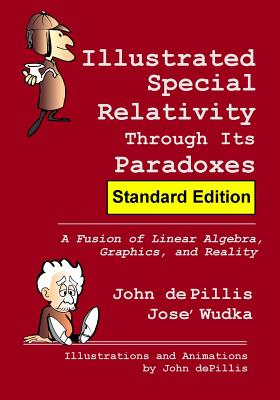
Illustrated Special Relativity Through Its Paradoxes: Standard Edition: A Fusion of Linear Algebra, Graphics, and Reality (Spectrum)
Description
This accessible work, with its plethora of full-color illustrations by the author, shows that linear algebra --- actually, 2x2 matrices --- provide a natural language for special relativity. The book includes an overview of linear algebra with all basic definitions and necessary theorems. There are exercises with hints for each chapter along with supplemental animations at
- special-relativity-illustrated.com.
Since Einstein acknowledged his debt to Clerk Maxwell in his seminal 1905 paper introducing the theory of special relativity, we fully develop Maxwell's four equations that unify the theories of electricity, optics, and magnetism. Using just two laboratory measurements, these equations lead to a simple calculation for the frame-independent speed of electromagnetic waves in a vacuum. (Maxwell himself was unaware that light was a special electromagnetic wave.)
Before analyzing the paradoxes, we establish their linear algebraic context. Inertial frames become ( 2-dimensional vector spaces ) whose ordered spacetime pairs ( x, t ) are linked by "line-of-sight" linear transformations. These are the Galilean transformations in classical physics, and the Lorentz transformations in the more general relativistic physics. The Lorentz transformation is easily derived once we show how a novel swiveled line theorem, ( a geometric concept ) is equivalent to the speed of light being invariant for all observers a ( a physical concept ).
Six paradoxes are all analyzed using Minkowski spacetime diagrams. These are (1) The Accommodating Universe paradox, (2) Time and distance asymmetry between frames, (3) The Twin paradox, (4) The Train-Tunnel paradox, (5) The Pea-Shooter paradox, and the lesser known (6) Bug-Rivet paradox. The Bug-Rivet paradox, animated by the author at Special-Relativity-Illustrated.com, presents another proof that rigidity is incompatible with special relativity.
E = mc2 finds a simple derivation using only the relativistic addition of speeds ( the Pea-Shooter paradox ), conservation of momentum, and a power series.
Finally, three appendices contain the self-contained overview of linear algebra, key properties of hyperbolic functions used to add relativistic speeds graphically, and a deconstruction of a moving train that proves the non-intuitive fact that when a moving train pulls into a station, its front car is always younger than its rear car, even though the front car has been in the station for a longer time.
Both this standard edition (red cover) and the Deluxe edition (blue cover) contain all the previous topics.
The Deluxe edition (blue cover) will add 74 pages containing chapters on
- Dimensional Analysis.
- Mathematical Rings, which also shows why a minus x minus is positive.
- The Scientific Method, a self-correcting intellectual invention.
- Mathematical Logic outlines the "algebraic" structure of thought. From this we learn that Sherlock Holmes almost never deduced anything
- Early Attempts to Measure the Speed of Light, and how these primitive efforts were uncannily accurate. A bonus in this chapter is a 20-second experiment that allows the reader to measure the speed of light using any kitchen microwave.
